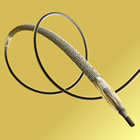|
CE Mark for 4.5 and 5.0mm Sizes of Medtronic Resolute Onyx Drug-Eluting Stent
DES Also Gets Specific Indication for Treatment of Left Main Disease
|
 |

Resolute Onyx™ Drug-Eluting Stent |
February 1, 2016 -- "Do you have that in Extra-Large?" In a department store, the answer is probably "yes," but in the catheterization laboratory, the answer usually has been "no." Until today, when the European regulatory agency, Conformité Européene, approved new sizes of Medtronic's drug-eluting stent, the Resolute Onyx™, in 4.5 and 5.0mm diameters. Additionally the device received the CE Mark for the treatment of the left main artery.
Until relatively recently, left main disease, a particularly challenging clinical scenario, was treated exclusively with coronary artery bypass graft surgery (CABG). But as stent technology advanced, more cases were treated interventionally, without open surgery. This can be particularly critical when the patient presents with an infarcted vessel and time is of the essence.
One of the limitations to using stents in the left main is that the vessel is often wider than the largest diameter stent available, which affects the outcome of the procedure. What makes these new approvals important was summed up to Angioplasty.Org by Dr. David Hildick-Smith, principal investigator for the study that resulted in today's approval:

Dr. David Hildick-Smith |
"I think it is an excellent development that we will now have a DES which is ideally suited to the diameter of the Left Main.
"Previously we have had to take smaller stents and post-dilate them to the desired diameter and on occasions this might result in overstretching of the stent with loss of the ideal stent-to-artery ratio and drug concentration."
Dr. Hildick-Smith also was the first to perform a left main angioplasty with this new stent size, done last June at Royal Sussex County Hospital in Brighton, UK in a heart attack patient who, according to a news report, had only a 20% chance of survival.
Other problems with having to over-expand smaller stents to fit a large artery include disruption of the polymer coating and fracture of the thin stent struts, either of which could result in higher chance of restenosis and poorer outcomes.
The Resolute Onyx is currently the largest diameter drug-eluting stent available from a major manufacturer and the only one that now has a specific indication for the treatment of left main disease (previously only done "off-label"). Furthermore, the unexpanded profile of this larger stent is virtually the same as the smaller sizes, facilitating its use via the transradial approach.
It is possible that stents designs, such as the Resolute Onyx, may change the preferred treatment for left main disease. The major study of left main treatment to date, the SYNTAX trial, which set the benchmarks for appropriateness of stent vs. CABG, was performed with a first generation drug-eluting stent, the Taxus Express from Boston Scientific, with thicker struts and polymers, and less-effective drugs. As these newer devices become available and utilized, the SYNTAX scores, indicating which treatment option is most appropriate, may be altered significantly.
Interestingly, a year ago, Medtronic began its U.S. study of the Resolute Onyx, looking for eventual approval by the FDA, and an important subset of that study was Onyx's use in the smallest coronary arteries with diameters of 2.0mm.
This morning's press release from Medtronic follows:

Medtronic Adds New Resolute Onyx™ Drug-Eluting Stent Sizes and Expands Indications
New Extra-Large Vessel Stent Sizes and Indications in the EU Expand Treatment Options for Patients with Coronary Artery Disease
February 1, 2016 -- Dublin -- Medtronic plc (NYSE: MDT) today announced the recent CE (Conformité Européene) Mark and commercial launch for an expanded size matrix of the Resolute Onyx DES, a next generation drug-eluting stent that is now available in 4.5mm and 5.0mm diameter sizes. The CE Mark also approved several new product indications including treatment of left main vessels and small vessels. Many coronary vessels are large in diameter of which a sub-set are left main, and now physicians can treat these large vessels with optimally sized stents that provide appropriate drug concentration. Resolute Onyx is the first DES available in these sizes among major manufacturers, offering the broadest size matrix to optimize the treatment of complex clinical scenarios. The Resolute Onyx DES is not commercially available in the United States.
Treatment of the left main coronary artery is critical as the artery supplies the majority of blood to the left side of the heart; a narrowing in this vessel can place the patient at high risk for life-threatening events. Due to the lack of optimally sized drug-eluting stents available to date to treat large coronary arteries, these patients historically have been treated with undersized stents or with coronary artery bypass graft surgery (CABG). CABG can be more invasive and may require a longer recovery period than treatment with drug-eluting stents, while under-sized stents may have compromised stent scaffold integrity and disrupted polymer coating when over-expanded.
Resolute Onyx DES is well suited to treat large coronary vessels including the left main coronary artery with its optimal sizes and conformability in bifurcation lesions due to Continuous Sinusoid Technology.
"My initial clinical experience with the large sizes of the Resolute Onyx DES has been exceptional, as they alleviate many of the procedural challenges that existed when smaller stents were often the only option for large vessels," said David Hildick-Smith, M.D., principal investigator of the EBC Main Study who performed the first patient case with the larger sized Resolute Onyx from the Brighton and Sussex University Hospitals NHS Trust in Brighton, United Kingdom. "In addition, the left main indication of Resolute Onyx, coupled with its advanced stent design, provides physicians with a novel device that maintains its scaffold integrity with increased radial force, which is especially beneficial when treating bifurcation lesions in large vessels."
Built on the proven clinical performance and superior deliverability of the Resolute Integrity DES, the expanded sizes feature the same CoreWire Technology that allows the stent to have a denser core metal wrapped in a cobalt alloy outer layer. This technology enables increased radiopacity (i.e., visibility during the procedure) and has thinner struts to help improve deliverability without compromising radial and longitudinal strength. The full size matrix of Resolute Onyx features a delivery system with PowerTrac™ technology that provides enhanced deliverability through challenging lesions.
"The expanded size matrix of Resolute Onyx, and the new indication to treat the left main vessel, further delivers on our promise to provide the interventional community with stent innovations that address unmet clinical needs seen in everyday clinical practice," said Jason Weidman, vice president and general manager of the coronary and renal denervation business unit at Medtronic. "We now have a stent that treats a broader range of patient anatomies - from large to small - than any other major DES on the EU market."
In collaboration with leading clinicians, researchers and scientists worldwide, Medtronic offers the broadest range of innovative medical technology for the interventional and surgical treatment of cardiovascular disease and cardiac arrhythmias. The company strives to offer products and services that deliver clinical and economic value to healthcare consumers and providers around the world.
About Medtronic
Medtronic plc (www.medtronic.com), headquartered in Dublin, Ireland, is among the world's largest medical technology, services and solutions companies - alleviating pain, restoring health and extending life for millions of people around the world. Medtronic employs more than 85,000 people worldwide, serving physicians, hospitals and patients in approximately 160 countries. The company is focused on collaborating with stakeholders around the world to take healthcare Further, Together.
Any forward-looking statements are subject to risks and uncertainties such as those described in Medtronic's periodic reports on file with the Securities and Exchange Commission. Actual results may differ materially from anticipated results.
Reported by Burt Cohen, February 1, 2016
|


